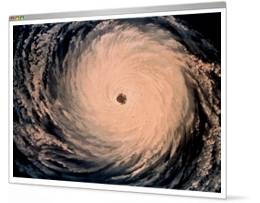My UPD8
You need to login before you download the free activities. You can register here.
- The Centre for Science Education
- The Association for Science Education
- Partners
- Part of ASE online
Hurricane force

Type: Activity
Learning Strategy: Modelling
Topic: States of matter
August 2004 was a record month for Atlantic hurricanes, and the media has been filled with disaster photographs. This activity promotes discussion of the destruction caused when a hurricane hits land.
Students apply knowledge of the particle model of gases to account for the wind's violence. A thinking model is developed to address the misconception that air is nothing and weightless.
Published: 4th January 2005
Reviews & Comments: 1
Learning objectives
Students will: refer to particles when describing the force exerted by winds and recognise that air has mass.
Try the activity
- Teachers notes
Downloaded: 1154 times - Activity sheet
Downloaded: 1672 times
You will need Acrobat Reader installed to open the activity sheets.
Curriculum link
QCA Unit 7GDescribe the movement and arrangement of particles to explain phenomena.
Running the activity
Timing starter - 5 minutes; main 20 minutes; plenary 5 minutes
Starter activity: Project the disaster scene image (page 1), or display it on an OHP, as students enter the class. Initiate discussion of what the image shows. Possible questions include: "Have they heard other boy's or girl's names mentioned in connection with severe storms?"; "What sort of damage can these storms do?" Hurricanes are tropical storms originating in the Atlantic. They cause widespread damage if they hit land and can persist for up to two weeks. Most of the damage is caused by the torrential rain and raised sea-levels they bring but this activity focuses on wind damage.
Main Activity: Page 2 sets the scene with a text conversation between a girl caught in a hurricane and a friend in the UK. This could be used with paired readers. It describes the scene and poses 3 questions about fast moving air and its effects. The activity on page 3 helps students answer these questions and at the same time develops their concept of particles. Q1 deals with the composition of a hurricane. It uses a visualisation exercise reinforce students mental models of the behaviour of particles in a gas. Q2 addresses the misconception that air has no mass by getting students to calculate approximately how many kg of air their bedroom contains. Q3 deals with the force exerted by a hurricane. The two attributes of particles introduced by the previous questions - mass and movement - are brought together in a final visualisation exercise. Students could be reminded of previous learning activities as each question is tackled. E.g. Q 1 - weighing air, Q2 - kinetic theory model; Q3 - collapsing can experiment. For the first exercise, they could be asked to close their eyes while the teacher reads the script, or could work in pairs, taking it in turns to read.
Plenary: Pupils should be asked to talk to a partner about their learning and say what helped them to understand how the buildings got damaged and what visual images they have of hurricanes.
Web links
News links
- Forces of nature
- An excellent resource with pupil level access to an interactive animation of how hurricanes form, pupils can graphically set up their own hurricanes. This is also a good resource for pictures to insert into presentations
- NOAA
- A good source of data relating to the most recent hurricanes
- BBC Weather
- Links to the latest hurricane news.
Reviews & Comments
Write your online review to share your feedback and classroom tips with other teachers. How well does it work, how engaging is it, how did you use it, and how could it be improved?
Literacy
Oct 17th, 2007

I think the use of 'text talk' in this activity is appalling. The general concept is good, however this is completely overshadowed by the "texting". I find it shocking that this type of communication is being used to try and grab the interest of pupils. It only encourages poor literacy.
Reviewer: Lindsay Davison

200 lessons and assessments from as little as £4.95
Related Activities
Ideas about Science / Scientific theories
QCA / 7G Particle model of solids, liquids & gases
Hot Topics / Disaster
- PiggiFlu is coming
- The Day After Tomorrow: The Prequel
- The Day After Tomorrow
- Tsunami Warning
- So windy
- Arctic seed bank
- Attack of the giant viruses
Difficult & Dull / Particles
- Instant ice-cream
- Death of an angel
- Can Science catch a bomber?
- Making Rain
- Plane as big as a school
- Life on Enceladus?
Chemistry / States of matter
- Instant ice-cream
- Death of an angel
- Christmas trifle
- What's moving on Titan
- Making Rain
- Life on Enceladus?